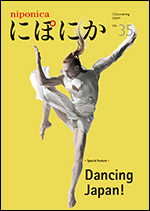
2023 NO.35
MenuDancing Japan!

A Japanese Intangible Cultural Heritage
Furyu-odori
Furyu-odori was inscribed on the UNESCO Resresentative List of the Intangible Cultural Heritage of Humanity in 2022. The word furyu originally meant something elegant and graceful, but eventually it came to refer to a group dance performed by a large number of people dressed in elaborate costumes. Let’s take a look at some of the tasteful dances that are still performed today in various parts of Japan.
Bon-odori in Nishimonai
Ugo Town, Akita Prefecture
Among the bon-odori dances that are danced during the Bon season in August when the spirits of the ancestors return, the Bon-odori in Nishimonai is considered to be exceptionally elegant. The hand gestures and footwork of the dancers, who hide their faces with woven hats and dark hoods to evoke the deceased, are supple and beautiful. Hanui kimono that are sewn together with pieces of silk cloth add further color to the dance. (Photo: PIXTA)
Bon-odori in Kemanai
Kazuno City, Akita Prefecture
In this richly moving bon-odori dance, the performers carry out relaxed gestures around a bonfire with their arms stretched out to their fingertips. Both men and women wear formal kimonos with black motifs, and cover their faces with polka-dotted tenugui hand towels. (Photo: Aflo)
Shiraishi-odori
Kasaoka City, Okayama Prefecture
This traditional dance of Shiraishi Island is said to have gotten its start as a way of mourning a samurai who died in a battle that took place in the 12th century. Several types of dances are performed at the same time to a single melody known as kudoki. Today, dancers draw on 13 types of dances handed down the generations. The harmony created by multiple dances with different costumes and moves is breathtaking. (Photo: Kasaoka City Office)
Nenbutsu-odori in Takinomiya
Ayagawa Town, Kagawa Prefecture
Every year in late August, this dance is held at Takinomiya Shrine and Takinomiya Tenmangu Shrine to give thanks to Sugawara Michizane, a poet and politician who saved many people from a massive drought during the Heian period and to pray for rain and an abundant harvest. Dancers called genji holding large fans dance while chanting Namu ami doya in sync with drums, bamboo flutes, gongs, and conch shells. (Photo: Ayagawa Town)
Yasurai-bana
Kyoto City, Kyoto Prefecture
In the spring when the cherry blossoms start falling, this dance is performed in four places in Kyoto—Imamiya, Kawakami, Genbu, and Kamigamo—as a prayer to appease evil spirits and plagues that bring about disasters. Dressed as elementals with red or black hair called shaguma, performers beat gongs and drums, play bamboo flutes, and parade through the streets singing lyrics including “yasurai-bana.” (Photo: Aflo)
Yoshihiro-gaku
Kunisaki City, Oita Prefecture
This dance is held at Gakuniwa Hachiman Shrine in July every year as a prayer to ward off insects from damaging agricultural crops. Musicians wearing koshimino straw raincoats around their waist and helmets on their heads perform this dynamic dance. (Photo: Kunisaki City)
Ayakomai
Kashiwazaki City, Niigata Prefecture
This performing art handed down over a period of some 500 years and performed in two theaters, Takanda and Shimono, consists of three parts: the kouta-odori danced by women, the hayashi-mai danced by men, and kyogen (noh farce). The kouta-odori is a captivating dance involving graceful footwork and supple fan gestures is performed by a girl wearing a red cloth called a yurai on her head. (Photo: Takahashi Masahito / Haga Library)
Chakkirako
Miura City, Kanagawa Prefecture
This dance is held at Kainan Shrine on the 15th day of the New Year to pray for good fortune in fishing and business. Girls dressed in red kimonos dance with two ayatake (bamboo sticks with bells and decorations) called chakkirako and fans, accompanied by the singing of elderly women. (Photo: Aflo)
Kanomizu-kakeodori
Gujo City, Gifu Prefecture

This dance is performed at an annual festival that has been held continuously for over 300 years at Hakusan Shrine in the Kanomizu district. They dance around with bamboo flower decorations called sinai on their backs, beating drums and gongs. Dancers wear a variety of costume, such as masks and hanagasa hats with flowers. (Photos: Gujo Tourism Federation)












